


-
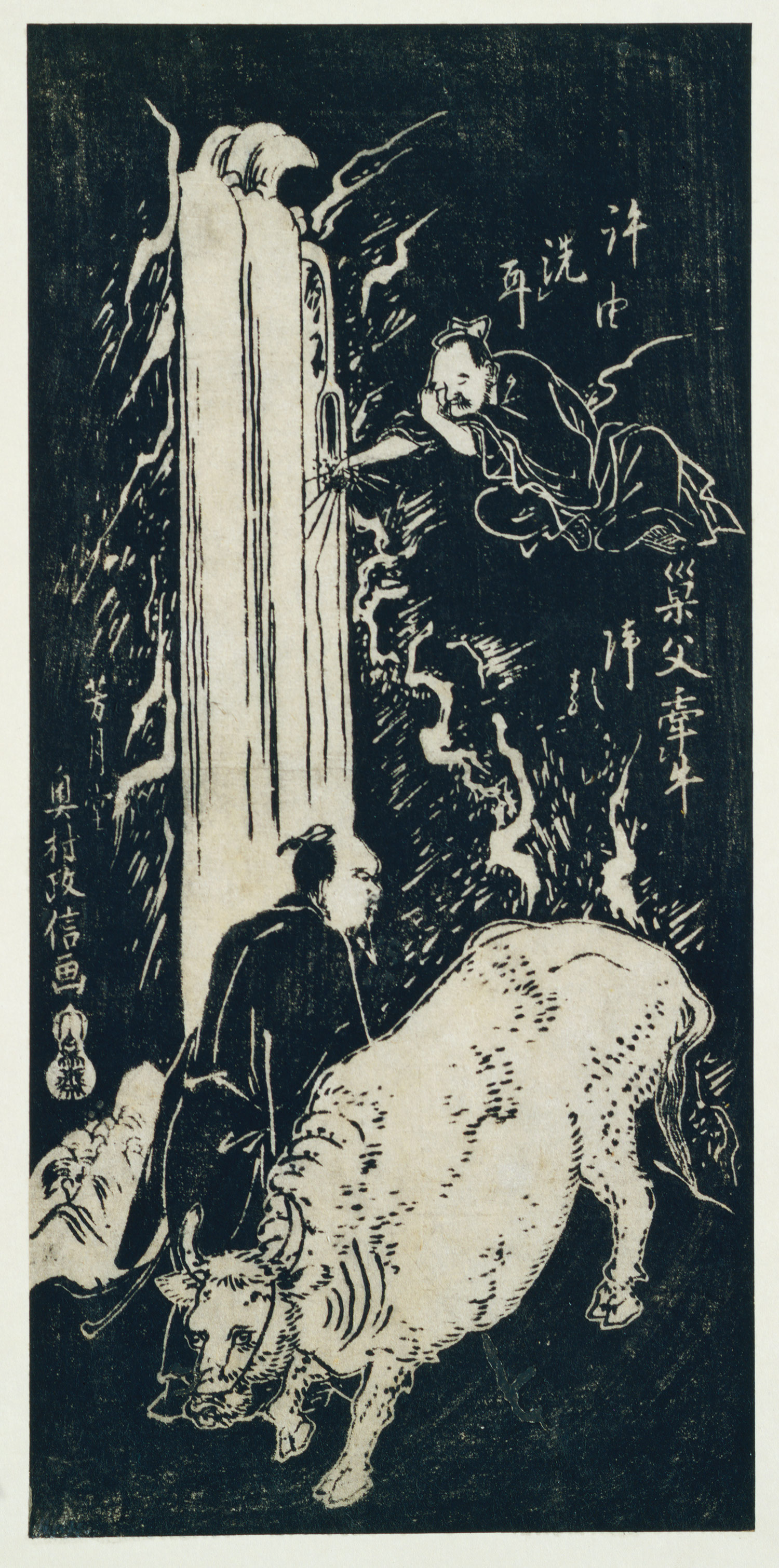
Kyoyu and Sofu, Edo period (1615–1868), 18th century
Okumura Masanobu (Japanese, 1686–1764)
"Stone rubbing" style woodblock print; ink on paper; H. 11 7/16 in. (29.1 cm), W. 5 1/2 in. (14 cm)
H. O. Havemeyer Collection, Bequest of Mrs. H. O. Havemeyer, 1929 (JP1589)
-
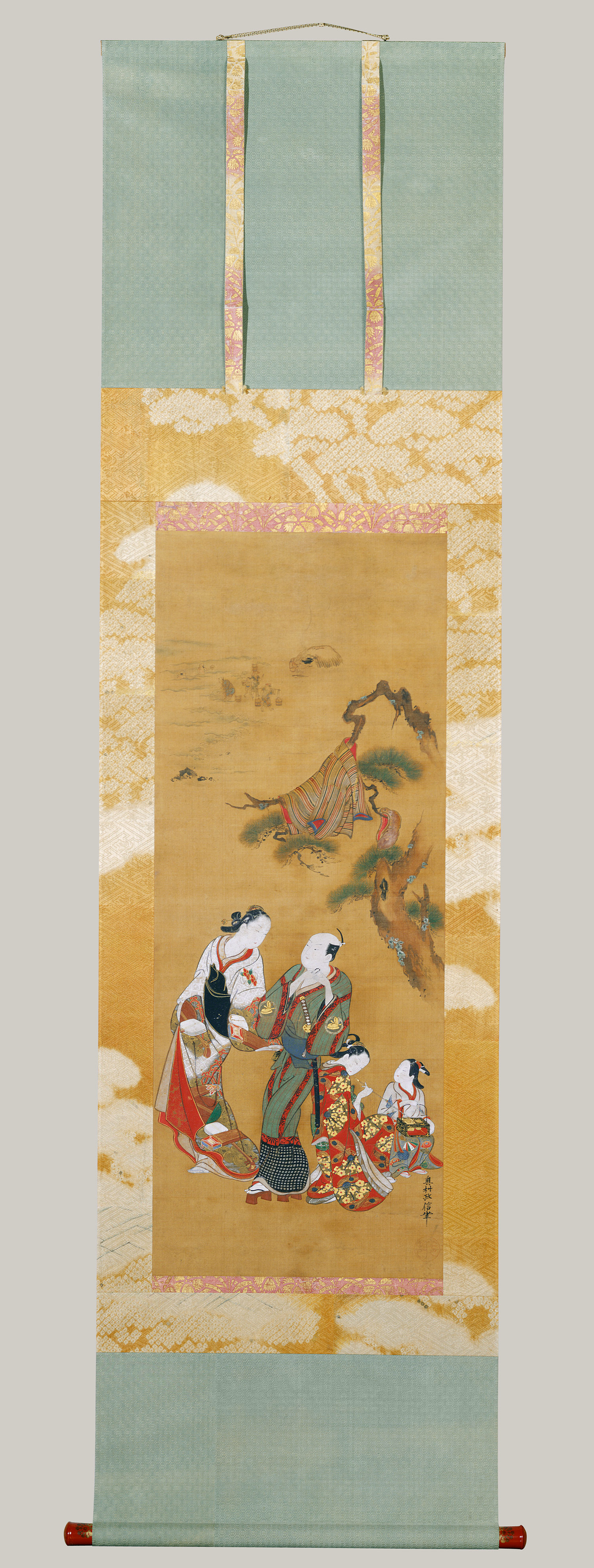
Yukihira and the Salt Maidens, Edo period (1615–1868), ca. 1716–35
Okumura Masanobu (Japanese, 1686–1764)
Hanging scroll; ink and color on silk
33 1/8 x 12 7/8 in. (84.1 x 32.7 cm)
The Harry G. C. Packard Collection of Asian Art, Gift of Harry G. C. Packard, and Purchase, Fletcher, Rogers, Harris Brisbane Dick, and Louis V. Bell Funds, Joseph Pulitzer Bequest and The Annenberg Fund Inc. Gift, 1975 (1975.268.126)
-
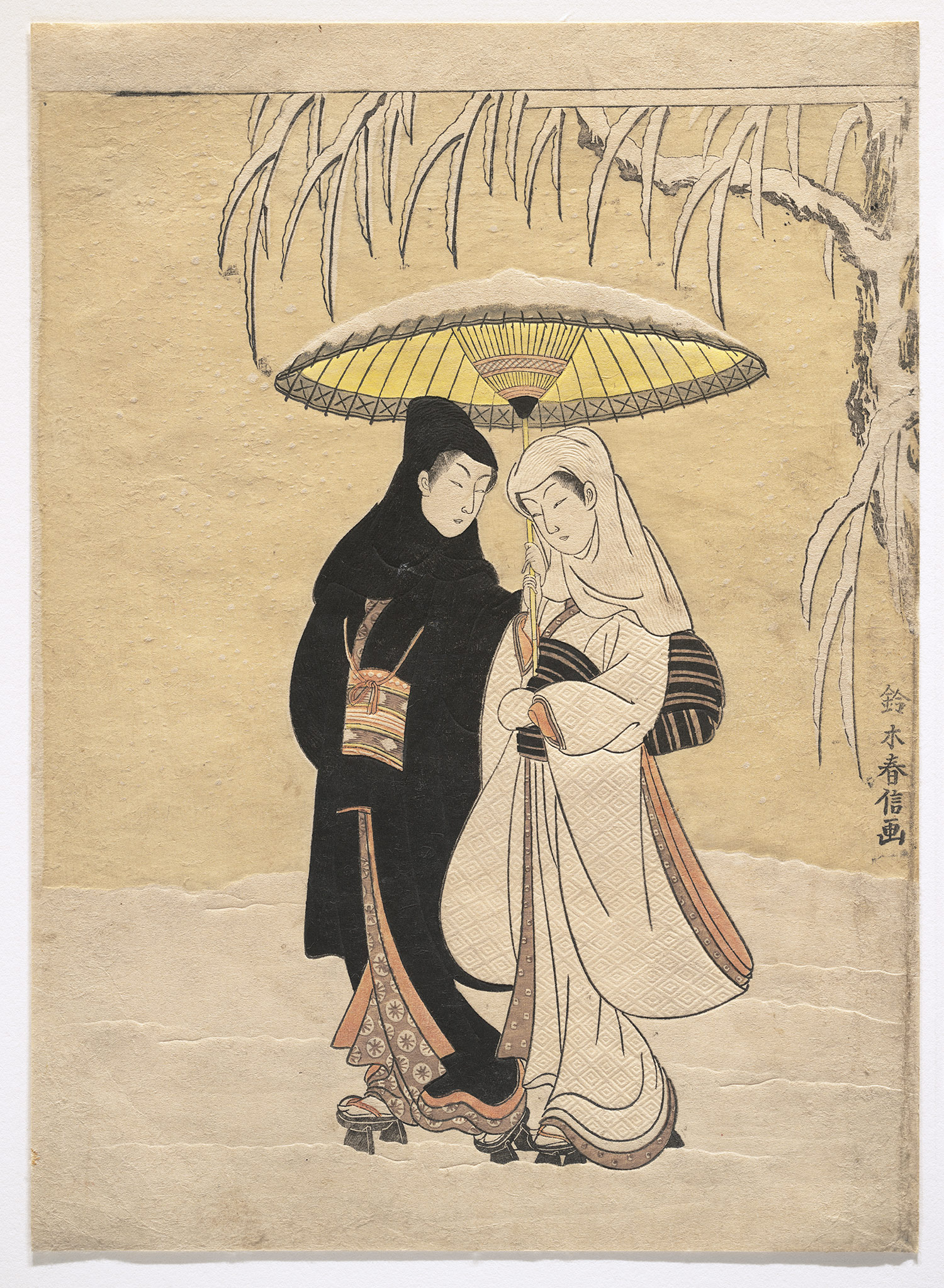
Crow and Heron, or Young Lovers Walking Together under an Umbrella in a Snowstorm, ca. 1769
Suzuki Harunobu (Japanese, 1725–1770)
Polychrome woodcut print on paper
11 1/4 x 8 1/8 in. (28.6 x 20.6 cm)
Rogers Fund, 1936 (JP2453)
-

Midnight: The Hours of the Rat; Mother and Sleepy Child, Edo period (1615–1868), ca. 1790
Kitagawa Utamaro (Japanese, 1753–1806)
Polychrome woodblock print
H. 14 3/8 in. (36.5 cm), W. 9 5/8 in. (24.4 cm)
Rogers Fund, 1922 (JP1278)
-
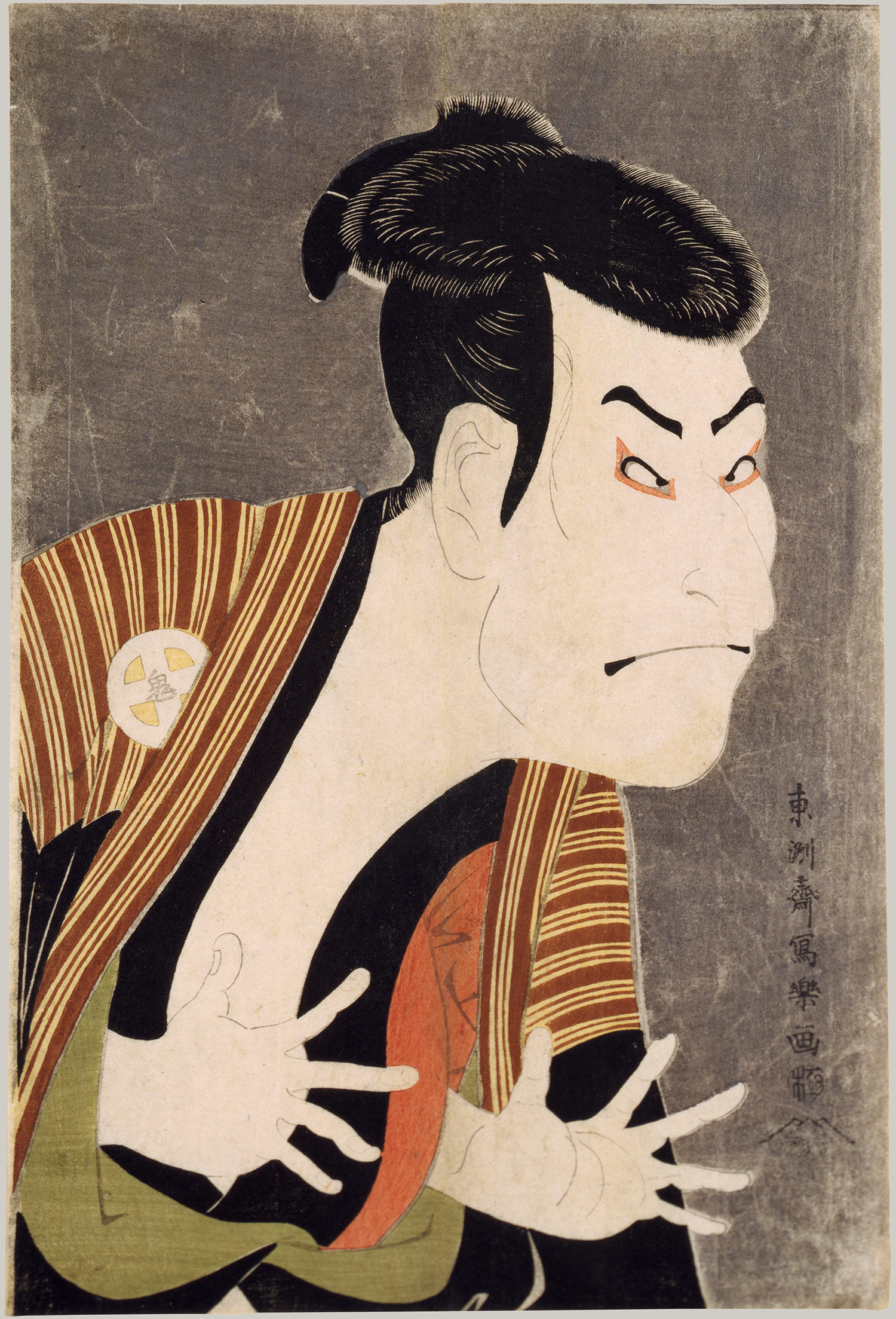
Otani Oniji II, dated 1794
Toshusai Sharaku (Japanese, active 1794–95)
Polychrome woodcut print on paper
15 x 9 7/8 in. (38.1 x 22.9 cm)
Henry L. Phillips Collection, Bequest of Henry L. Phillips, 1939 (JP2822)
-
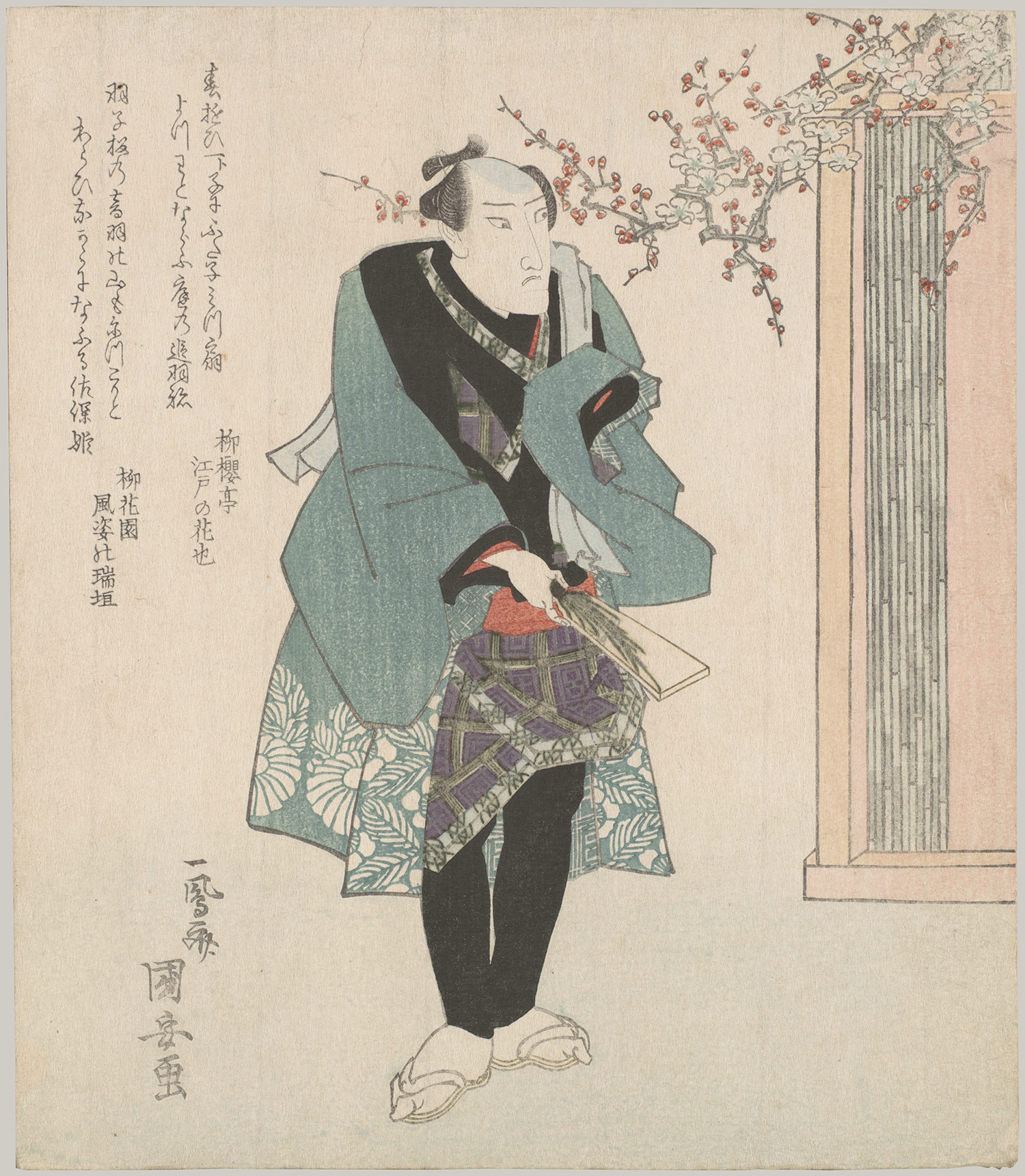
Three Kabuki Actors [from right to left]: Iwai Hanshiro V (1776–1847), Segawa Kikunojo (1802–1832), and Onoe Kikugoro III (1784–1849), Edo period (1615–1868), ca. 1823
Utagawa Kuniyasu (Japanese, 1794–1832)
Surimono, woodblock print; ink and color on paper
Triptych, each: 7 1/4 x 8 3/8 in. (18.4 x 21.3 cm)
Purchase, Jack Green Gift, 2001 (2001.715.4)
-
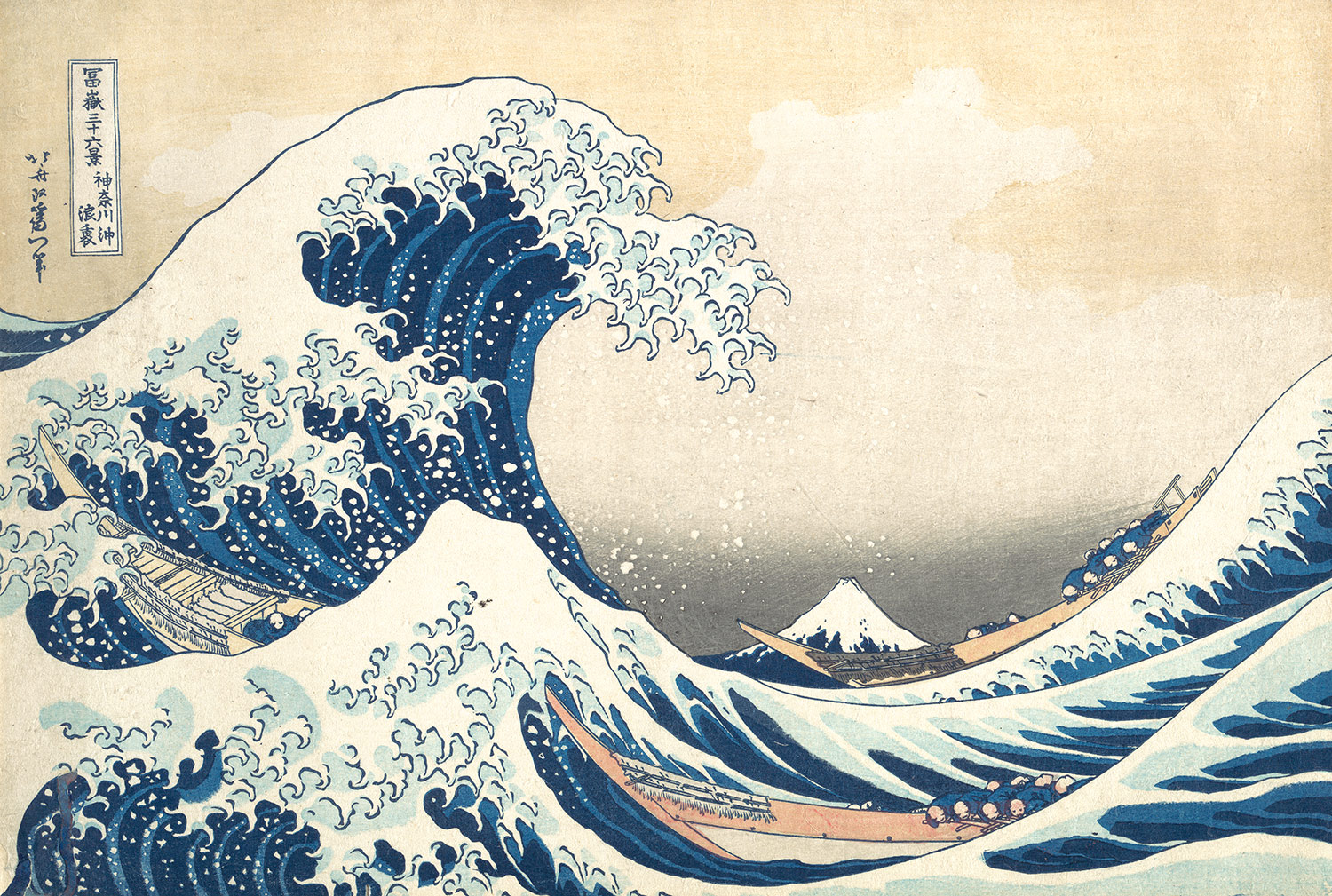
The Great Wave at Kanagawa (from a Series of Thirty-Six Views of Mount Fuji), Edo period (1615–1868), ca. 1831–33
Katsushika Hokusai (Japanese, 1760–1849); Published by Eijudo
Polychrome ink and color on paper
10 1/8 x 14 15/16 in. (25.7 x 37.9 cm) (Oban size)
H. O. Havemeyer Collection, Bequest of Mrs. H. O. Havemeyer, 1929 (JP1847)
-

Evening Snow at Kanbara, Edo period (1615–1868), 1834
Ando Hiroshige (Japanese, 1797–1858)
Woodblock print; ink and color on paper
8 7/8 x 13 3/4 in. (22.5 x 34.9 cm)
The Howard Mansfield Collection, Purchase, Rogers Fund, 1936 (JP2492)
-
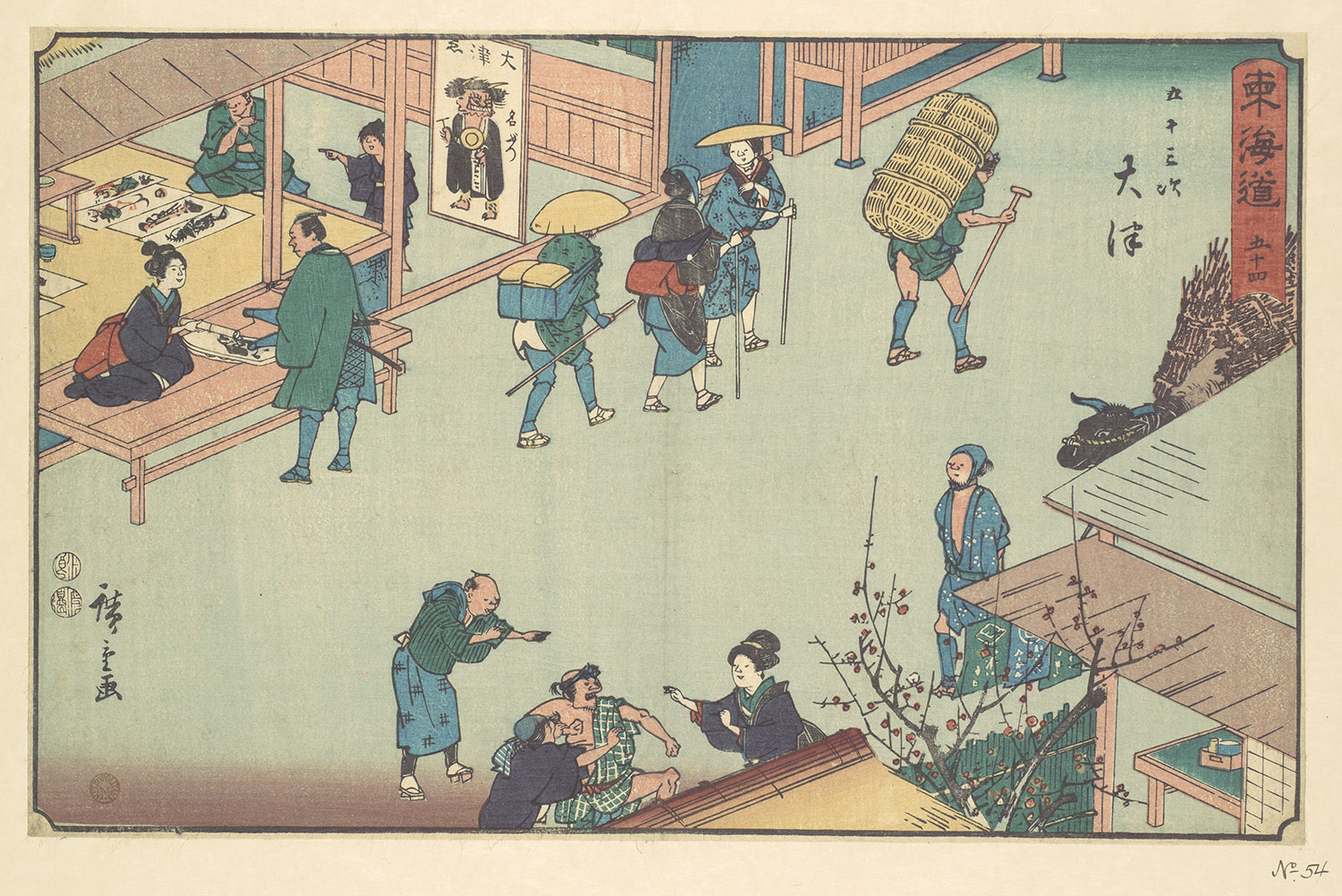
Station of Otsu: From the Fifty-three Stations of the Tokaido (The "Reisho Tokaido"), Edo period (1615–1868), ca. 1848–49
Ando Hiroshige (Japanese, 1797–1858)
Polychrome woodblock print
H. 8 23/32 in. (22.2 cm), W. 13 23/32 in. (34.9 cm)
Frederick Charles Hewitt Bequest Income, 1912 (JP804)
-
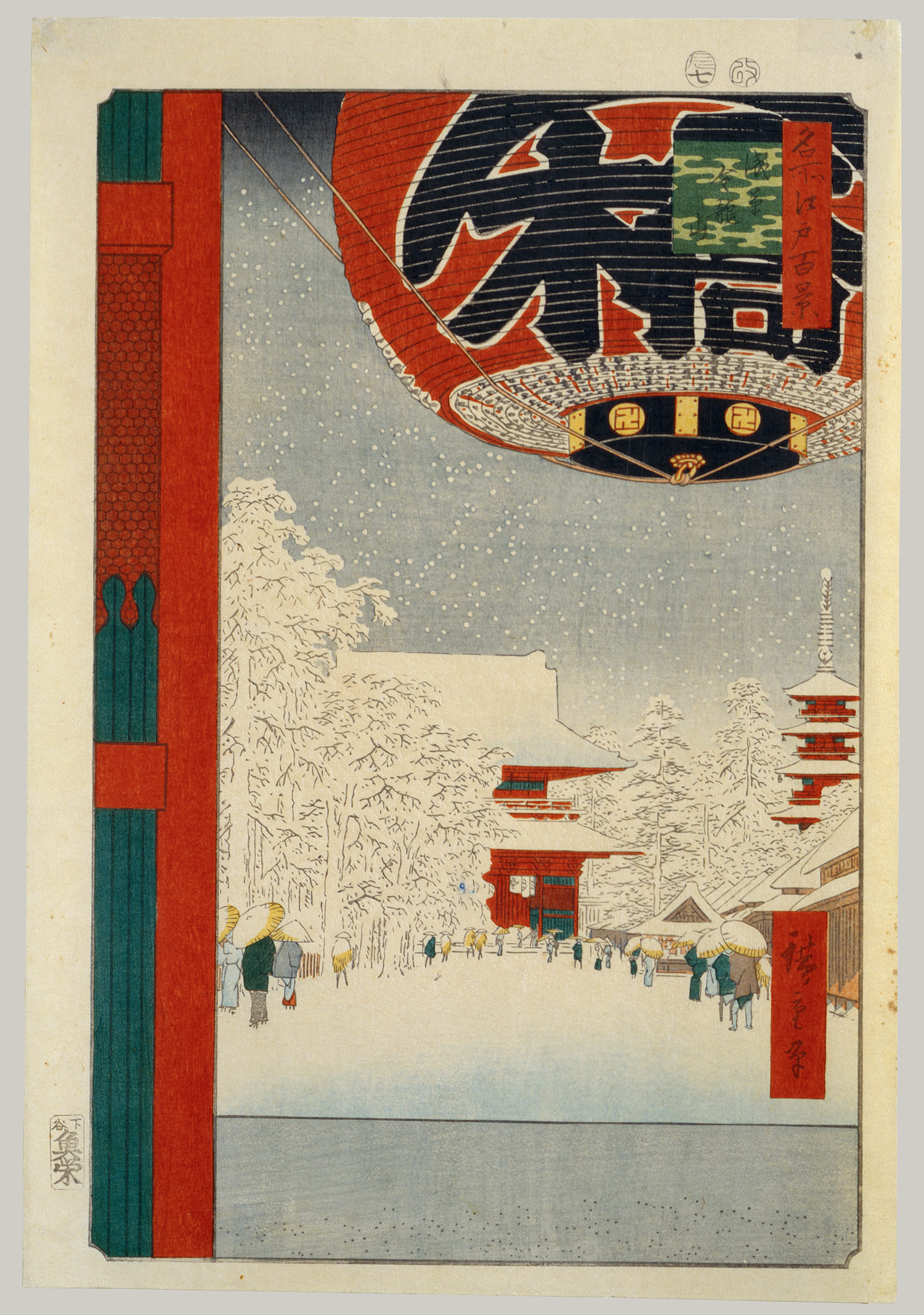
Kinryusan Temple at Asakusa: From the series One Hundred Famous Views of Edo, Edo period (1615–1868), 1856
Ando Hiroshige (Japanese, 1797–1858)
Oban format, woodblock print; ink and color on paper
H. 14 1/16 in. (35.7 cm), W. 9 1/2 in. (24.1 cm)
The Howard Mansfield Collection, Purchase, Rogers Fund, 1936 (JP2519)
-
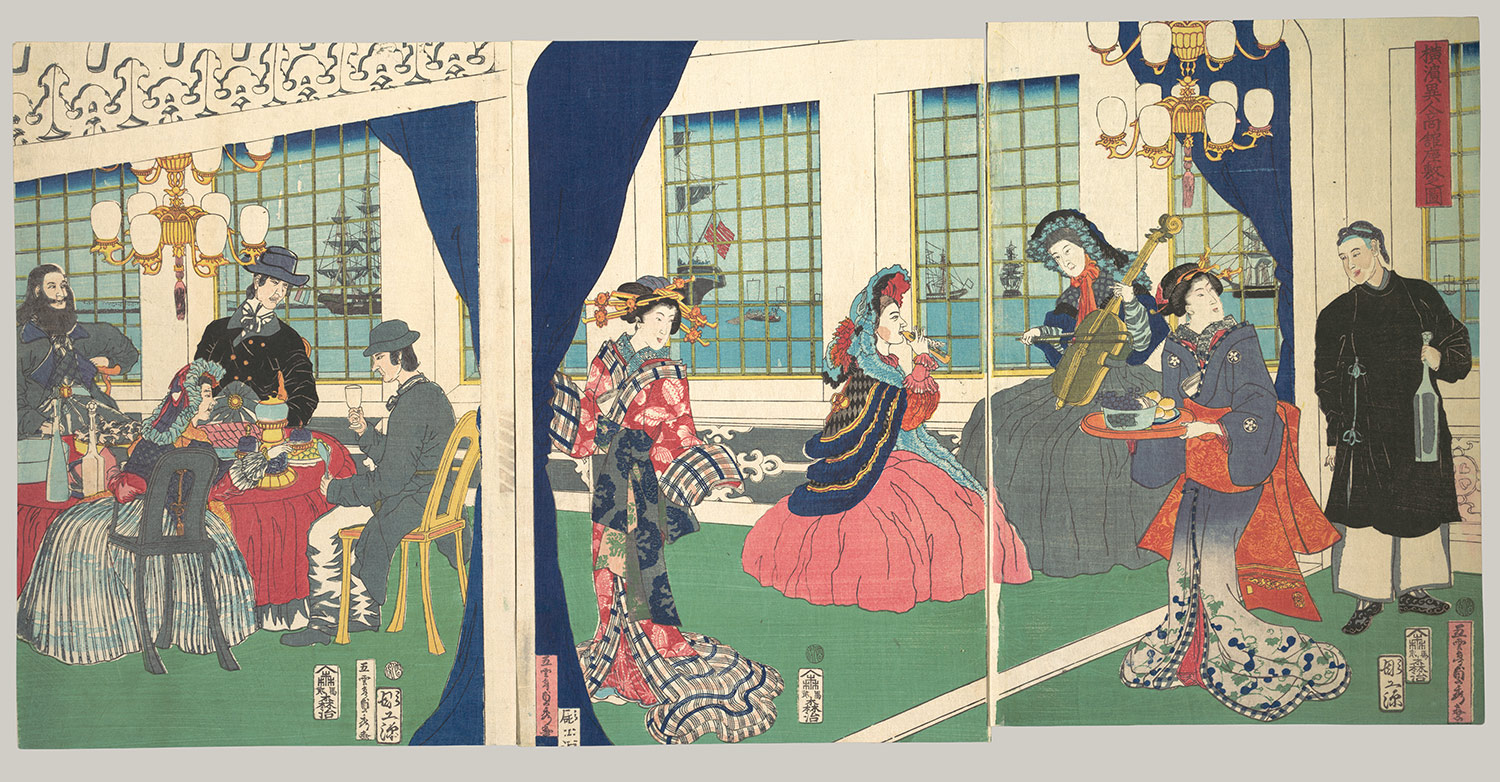
Foreigners in the Drawing Room of a Foreign Merchant's House in Yokohama, Edo period (1615–1868), September 1861
Gountei Sadahide (Japanese, 1807–1873)
Triptych of polychrome woodblock prints; ink and color on paper
14 x 9 3/4 in. (35.6 x 24.8 cm), 14 x 19 3/8 in. (35.6 x 23.8 cm), 14 x 10 7/8 in. (35.6 x 27.6 cm)
Bequest of William S. Lieberman, 2005 (2007.49.131a–c)
-
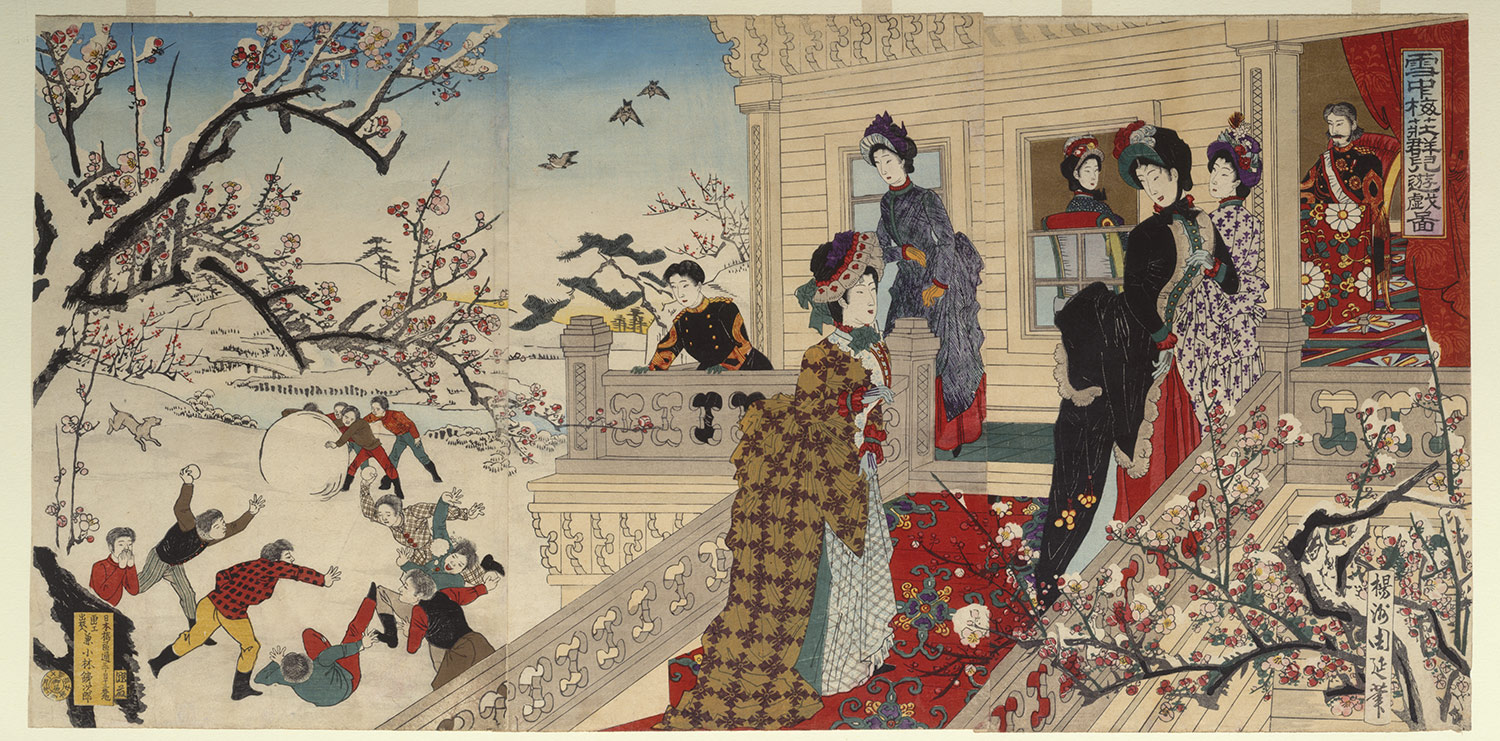
A Group of Children Playing under the Plum Blossoms in the Snow, 1887
Hashimoto Chikanobu (Japanese, 1838–1912)
Woodblock print
Gift of Lincoln Kirstein, 1959 (JP3341)
Woodblock prints were initially used as early as the eighth century in Japan to disseminate texts, especially Buddhist scriptures. The designer and painter Tawaraya Sotatsu (died ca. 1640) used wood stamps in the early seventeenth century to print designs on paper and silk. Until the eighteenth century, however, woodblock printing remained primarily a convenient method of reproducing written texts.
In 1765, new technology made it possible to produce single-sheet prints in a whole range of colors. Printmakers who had heretofore worked in monochrome and painted the colors in by hand, or had printed only a few colors, gradually came to use full polychrome painting to spectacular effect. The first polychrome prints, or nishiki-e, were calendars made on commission for a group of wealthy patrons in Edo, where it was the custom to exchange beautifully designed calendars at the beginning of the year.
Woodblock prints of the Edo period most frequently depicted the seductive courtesans and exciting kabuki actors (JP2822) of the urban pleasure districts. With time, their subject matter expanded to include famous romantic vistas and eventually, in the final years of the nineteenth century, dramatic historical events. These pictures could be made in great quantity and featured popular scenes that appealed in particular to the wealthy townspeople of the period.
Despite the fame of great print masters like Suzuki Harunobu (1725–1770) and Ando Hiroshige (1797–1858), each print required the collaboration of four experts: the designer, the engraver, the printer, and the publisher. A print was usually conceived and issued as a commercial venture by the publisher, who was often also a bookseller. It was he who chose the theme and determined the quality of the work. Designers were dependent on the skill and cooperation of their engravers and of the printers charged with executing their ideas in finished form.
A woodblock print image is first designed by the artist on paper and then transferred to a thin, partly transparent paper. Following the lines on the paper, now pasted to a wooden block usually of cherry wood, the carver chisels and cuts to create the original in negative—with the lines and areas to be colored raised in relief. Ink is applied to the surface of the woodblock. Rubbing a round pad over the back of a piece of paper laid over the top of the inked board makes a print.
Polychrome prints were made using a separate carved block for each color, which could number up to twenty. To print with precision using numerous blocks on a single paper sheet, a system of placing two cuts on the edge of each block to serve as alignment guides was employed. Paper made from the inner bark of mulberry trees was favored, as it was strong enough to withstand numerous rubbings on the various woodblocks and sufficiently absorbent to take up the ink and pigments. Reproductions, sometimes numbering in the thousands, could be made until the carvings on the woodblocks became worn.
Source: Woodblock Prints in the Ukiyo-e Style | Thematic Essay | Heilbrunn Timeline of Art History | The Metropolitan Museum of Art



























 Timelines (6)
Timelines (6)
No comments:
Post a Comment